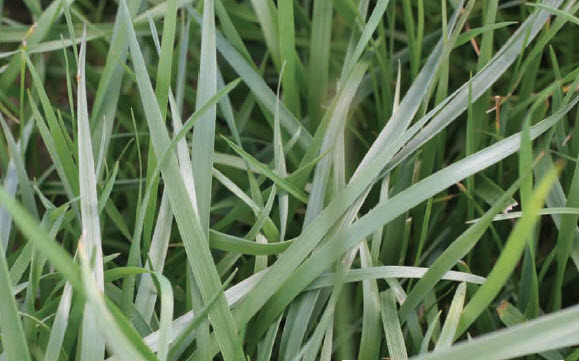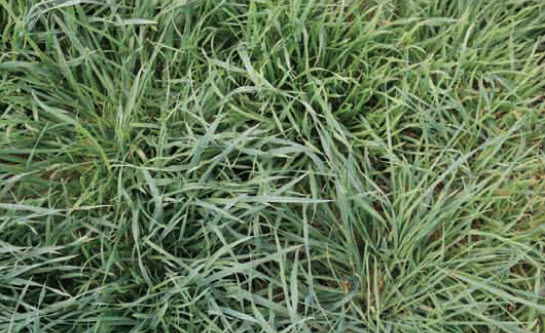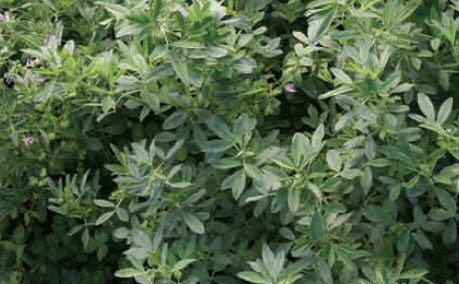- Pasture species should be selected so as to match the plant to its growing environment,
in terms of rainfall, temperature, length of growing season, soil characteristics and likely
pests and diseases
- The species selected should meet the production and environmental management
purposes of the pasture system, e.g. to provide high levels of feed year round or provide
protection against soil erosion
|
- The success of a species will depend on understanding and carrying out the appropriate
management requirements, e.g. fertiliser, liming and grazing management
- Advice on the suitability of species for a particular situation can be obtained from farmers
and agronomists
|
Pasture species commonly used that have
adapted well to local soils in Corangamite
|
For detailed information about the regional soils that are described in the following sections, refer to: Soils of the Corangamite Region.
Perennial ryegrass (Lolium perenne)
- Is the most widely sown perennial grass in south west Victoria and it provides
large quantities of high value feed across the many growing environments of the
region. It is a readily established, densely tillered plant
- Is well suited to medium and heavy textured soils with adequate soil phosphorus levels (Olsen P greater than 12 mg/kg), annual rainfall of more than
650 mm, a growing season of a least 7 months and mild summers
- It is well adapted to basalt soils (Sodosols and Chromosols) but may not persist
on lighter soils
- For more information about Perennial ryegrass:
Figure 1 - Perennial ryegrass - Photo: DEPI Victoria
Phalaris (Phalaris acquatica)
- Is the second most widely sown perennial grass in south west Victoria, after
perennial ryegrass
- It is the most drought tolerant grass species sown in the region, and is suited to
areas where summers are too hot for perennial ryegrass
- Is also important for controlling erosion and stabilising water tables
- Grows best on heavy textured, fertile soils, it withstands waterlogging and is
tolerant of moderate salinity
- It is sensitive to aluminium toxicity induced by soil acidity (pHc < 4.2) except
where the subsoil is only mildly acidic
- Soil testing to 60 cm depth, where acidity is likely to be of concern, is important to
determine if the use of lime is needed to aid persistence
- On black, cracking flats (Vertosols) phalaris is able to withstand the crickets that
can destroy othe pasture plants
- For more information about Phalaris:
Figure 2 - Phalaris - Photo: DEPI Victoria
|
Tall fescue (Fetusca arundinacea)
- Is a perennial grass, closely related to but more drought tolerant than perennial
ryegrass
- Extends the period of high value feed at the end of the growing season,
especially on later finishing, low lying areas. It is quite palatable and compatible
with white and sub clovers providing it is not allowed to dominate the pasture. It
can develop a tough sod, resilient to heavy trampling and frequent grazing
- Is a tufted, coarse-leaved species with erect tillers arising from rhizomes
(underground stems)
- Is well suited to areas receiving at least 600 mm rainfall. It is particularly able to
respond to summer rain/irrigation
- It is adapted to a wide range of soil types (medium to heavy texture), and a wide
range of soil fertility and soil pH levels
- Is the most tolerant grass for waterlogged areas and is well suited to shallow
Calcarosols and peaty soils with high pH, where it combines well with strawberry
clover
- Like perennial ryegrass and white clover, it is most productive if soil fertility is
high
- It is quite tolerant of soils with high aluminium content and is also tolerant of
moderate salinity
- For more information about Tall Fescue:

Figure 3 - Tall fescue - Photo: DEPI Victoria
Cocksfoot (Phalaris acquatica)
- Is a perennial grass that is well suited to free draining soil
- Its feeding value over the year is usually 5-10% lower than for other grasses,
however it is useful in south west Victoria, particularly in areas of low rainfall and
strongly acidic and low fertility soils, because of its ability to persist and its lack of
substances toxic to grazing stock
- The summer growth of cocksfoot is better than perennial ryegrass and phalaris,
although it is generally less drought tolerant than phalaris
- Is a deep rooted plant, with an upright growth habit. It is native to Europe,
northern Africa and temperate Asia
- Most cocksfoot cultivars have poor tolerance of waterlogging
- In areas where the soil pH and aluminium level limit the growth of phalaris,
cocksfoot may be more persistent and should be included in the seed mix
- It is well suited to the stony and gravely rises and granitic soils (sandy and loamy
Chromosols, and Tenosols) in south west Victoria
- For more information about Cocksfoot:

Figure 4 - Cocksfoot - Photo: DEPI Victoria
|
Lucerne (Medicago sativa)
- Is suitable for forage conservation and is often grown as a pure stand for hay
production or grazing
- It is also a valuable species to provide quality forage over summer
- Is a perennial legume with a long tap root, which enables it to use soil water
available at depth, and it is very drought tolerant
- It grows best on deep, well drained soils and will not tolerate waterlogging
- Is sensitive to soil acidity and exchangeable aluminium. If the exchangeable
aluminium level in the top 10 cm of soil is above 15 mg/kg (KCl extract), liming
prior to sowing is critical for the establishment, persistence and productivity of
lucerne
- If the level of exchangeable aluminium in the subsoil is greater than 15 mg/kg,
the soil is not suitable for Lucerne production
- The success of lucerne in south west Victoria depends on establishing lucerne on
suitable soils or modifying the soil, especially with regards to soil pH and
drainage
- For more information about Lucerne:

Figure 5 - Lucerne - Photo: DEPI Victoria
Subclover (Trifolium subterraneaum)
- Is the most important annual legume sown in south west Victoria
- There is a wide range of cultivars adapted to a wide range of soils and climate;
and through its habit of burying seed, sub clover is uniquely persistent under
heavy stocking and continuous grazing
- It requires soil phosphorus levels above 12 mg/kg (Olsen P) to grow well
- For more information about Sub clover:
Figure 6 - Sub clover - Photo: DEPI Victoria
|
White clover (Trifolium repens)
- Is a perennial legume that produces herbage of the highest nutritive value of any
species. It can, however, cause bloat in cattle
- Requires at least 700 mm annual rainfall and persists on a wide range of soils
provided moisture is available through the growing season
- It responds well to improved soil fertility but does not like highly acidic soil
- At the low rainfall limit, white clover is sometimes country. This provides a high
quality special purpose summer pasture that may remain valuable for 2-3 years
- For more information about White clover:
Figure 7 - White clover - Photo: DEPI Victoria
Arrowleaf clover (Trifolium vesiculosum)
- First commercialised in the USA, it is an annual lgume suited to well-drained
soil
- It grows slowly in winter but grows late and provides quality feed into January-
February
- For more information about Arrowleaf clover:
Figure 8 - Arrowleaf clover - Photo: DEPI Victoria
|
Persian clover (Trifolium resupinatum)
- Is an erect growing annual legume, often sown alone as a hay crop or with Italian
ryegrass or oats
- Can provide high yields of high-quality feed in spring and early summer
- It is high in water soluble carbohydrates and exhibits high intake characteristics. It
makes very good quality hay but is quite vulnerable to rain damage and should
be moved under cover quickly
- Recovers well from grazing and after it has been cut for hay
- Requires an annual rainfall of at least 550 mm and can grow well on many soils
- Liming to pHw 5.8 has given significant yield increases
- It grows best on fertile clay loam soils and is highly tolerant of waterlogged
conditions and moderate salinity
- For more information about Persian clover:
Figure 9 - Persian clover - Photo: DEPI Victoria
Balansa clover (Trifolium michelianum)
- Is an annual legume which is often sown with a short-lived ryegrass, as a 1-year
special purpose forage crop
- Is highly tolerant of waterlogging, moderately tolerant of salinity and is used in
areas receiving at least 500 mm annual rainfall
- It has a high level of hard-seededness
- The cultivar Bolta is suited to the wetter parts of south west Victoria; where
Paradana should be used in the drier areas
- For more information about Balansa clover:
Figure 10 - Balansa clover - Photo: DEPI Victoria
|
Strawberry Clover (Trifolium fragiferum)
- Is suited to waterlogged, heavy soils where white and sub clovers grow poorly
- It is also well suited to saline soil but needs at least 500 mm rainfall
- Has two main applications. It provides quality valuable summer feed on heavy/
peaty flats that remain moist in summer. Such land often has a high pH, which
strawberry clover will tolerate, however it will also encourage barley grass which
should be spray-grazed in spring
- Is well suited to clay flats and gilgai on the basalt plains (Vertosols), which get
waterlogged or stay damp for long periods. In these situations strawberry clover
persists and provides patches of valuable green feed over summer
- For more information about Strawberry clover:
Figure 11 - Strawberry clover - Photo: DEPI Victoria
|
Chicory (Cichorium intybus)
- Is a highly palatable perennial herb, providing high value forage in spring-
summer
- It has a high digestibility and is a good source of minerals
- It is compatible in pasture mixes with legumes, but has poor winter growth
- Chicory is a tap-rooted plant that has good drought tolerance
- While chicory requires well-drained soil, compared with lucerne it is more tolerant
of a wider range of winter-wet soils and is not as sensitive to soil acidity
- For more information about Chicory:
Figure 12 - Chicory - Photo: DEPI Victoria
|
Plantain (Plantago lanceolata)
- Is a palatable perennial herb that performs well in pasture and is a good source
of minerals (especially copper and selenium)
- It is a tap-rooted species that is very heat and drought tolerant
- For more information about Plantain:
Figure 13 - Plantain - Photo: DEPI Victoria
|
Other related questions in the Brown Book
|
|
Brown Book content has been based on published information listed in the Resources and References sections below
|
- Pasture Selection A collaboration between AWI, GRDC, MLA, RIRDC and Dairy
Australia
- The Pasture Selection Tool is a powerful tool for selecting pasture species suitable for your local conditions (Corangamite region)
- Evergraze Factsheets - More livestock from perennials - A collaboration between AWI,
GRDC, MLA, RIRDC and Dairy Australia
|
|
- Lisa Miller DPI Geelong - pers. comm..
- Species and cultivars for improved pastures (Chapter 3). Greener Pastures for south west Victoria. (2006) - Department of Primary Industries, Victoria.
|
|
|